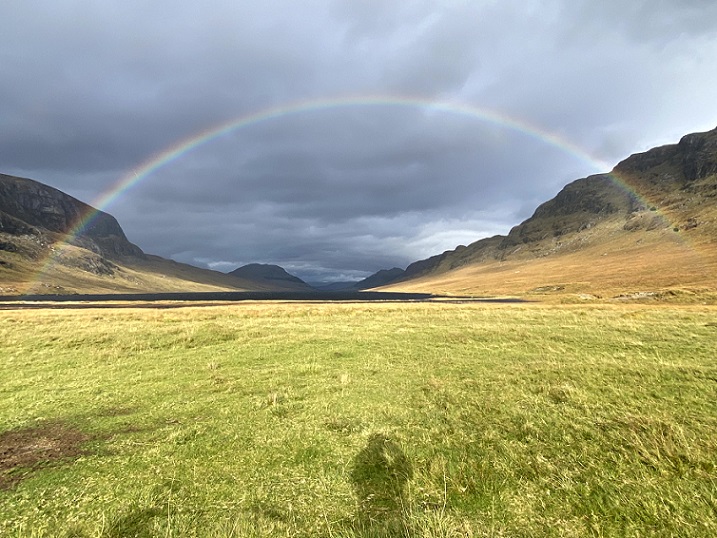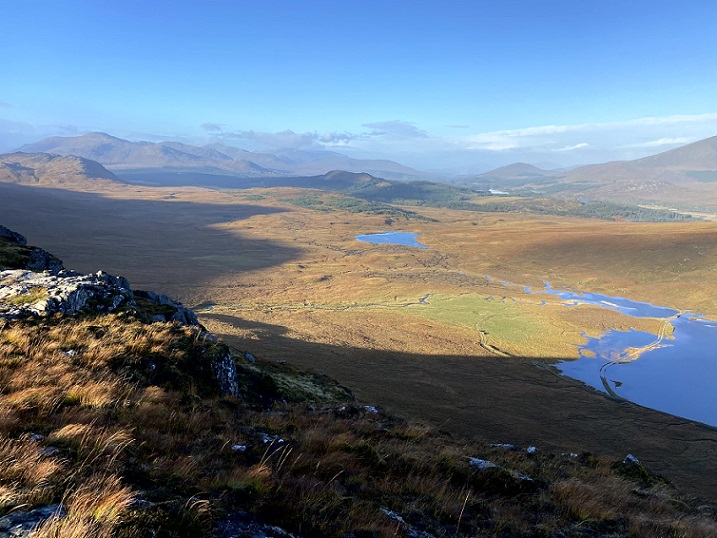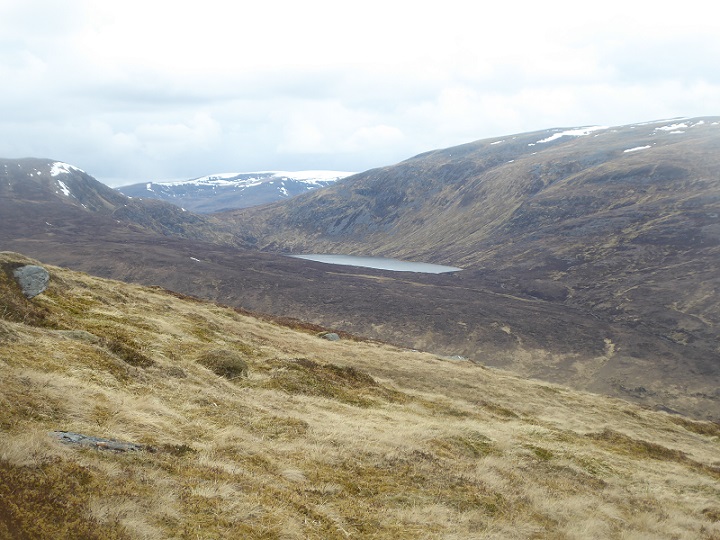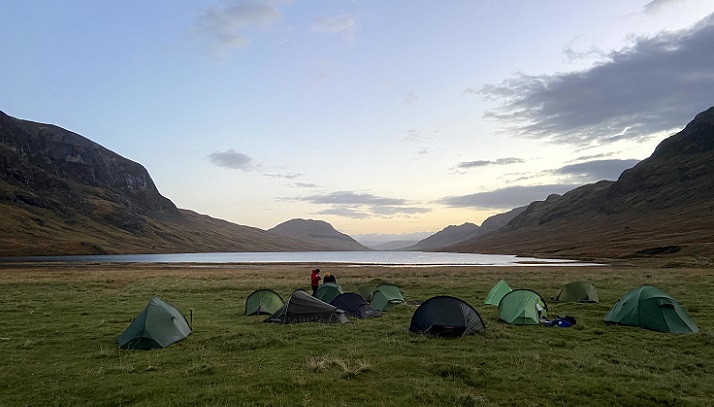
On 1st February Gilkes Hydro announced proposals (see here) to create a new pumped storage hydro scheme on the Ardverikie Estate in a beautiful and unspoiled area:
“At up to 900MW installed capacity and 33,000MWh stored energy, this will be the largest such project in the UK”.
 If constructed, the scheme would link Lochan na h-Earba, which is actually two lochs, with Loch a’ Bhealaich Leamhain, on the other side of the col linking the Munros Geal Charn and Beinn a’ Chlachair. The proposal is to raise Lochan na h-Earba by 20m and build a 900m dam 65m high across the outfall of Loch a’ Bhealaich Leamhain. Water will then be pumped up or flow down underground pipes between the two reservoirs, with the powerhouse (mainly underground) sitting on the shore of Lochan na h-Earba.
If constructed, the scheme would link Lochan na h-Earba, which is actually two lochs, with Loch a’ Bhealaich Leamhain, on the other side of the col linking the Munros Geal Charn and Beinn a’ Chlachair. The proposal is to raise Lochan na h-Earba by 20m and build a 900m dam 65m high across the outfall of Loch a’ Bhealaich Leamhain. Water will then be pumped up or flow down underground pipes between the two reservoirs, with the powerhouse (mainly underground) sitting on the shore of Lochan na h-Earba.

The project now has its own website (see here) and it is worth viewing the flyovers to appreciate the existing landscape.

Imagine a 900 x 65m rock wall built across the end of this loch. It will dominate the landscape and be visible from the Drumochter Hills, Beinn Udlamain and A’Mharconaich, across Loch Ericht in the Cairngorms National Park. Having objected to wind-farms visible from its borders, one would expect the Cairngorms National Park Authority also to object to this scheme.
There will also be a permanent access road up to the new reservoir.
From close up the landscape impact of this dam and that of Lochan na h-Earba below will be even worse. For pumped storage to deliver as much power as possible, sometimes the reservoirs must be full, sometimes almost empty. After 36 hours of electricity generation, anyone walking around the top reservoir will be looking down into a 200ft deep hole.

There is already a small dam across the west end of Lochan na h-Earba, visible in the second photo above, which has helped create a small strip of shoreline denuded of vegetation on either side of the loch, which you can see in the photo above.
Now imagine that Lochan na h-Earba rises and falls not just by 1-2m but 20m or possibly more in a dry summer! Scars along the shore will dominate the landscape when water has been pumped up to Loch a’ Bhealaich Leamhain above. Associated with this will be a wide range of adverse ecological impacts which Ron Greer described on parkswatch almost five year ago in The hidden horrors of hydro.

The impact on outdoor recreation will also be considerable, whether this is camping, climbing, walking, biking or horseriding.
The climate emergency and the need to store power
We need to make renewable energy work if we are to save the planet and save humanity. That means we need to devise ways to store electricity that is produced from intermittent sources like wind. At present there are three main ways this could be done (apart from polluting batteries): pumped storage, hydrogen storage or compressed air storage. Of these options, pumped storage, while an inefficient use of energy, is at present significantly cheaper but by 2030 is predicted to be more expensive than hydrogen storage (see here). That is only seven years away and given Gilkes say this scheme could take three- four years to build suggests there are good green reasons to be sceptical about the need for this scheme. In addition there needs to be a proper calculation of the carbon emissions that would be produced by the construction of schemes such as this.
However, even if we do need more pumped storage in Scotland – and I would be happy to concede that the climate emergency is such that we cannot afford to wait to see if hydrogen technology becomes more viable – why does the scheme need to be constructed at Lochan na h-Earba? Are there no better locations?
The logical thing for Scotland to do – and I was pleased to be quoted saying this in a piece on the scheme in the Herald last Sunday (see here) – would be to:
- work out what out what pumped storage capacity we need
- work out whether this is best delivered through one or more big schemes or several smaller schemes (which might spread the risk of drought better)
- then identify the locations that pumped storage would do least to the natural environment
Unfortunately, the Scottish Government under Nicola Sturgeon’s leadership could see no further than the private market and instead of doing this work has left energy developers to respond.
The new policy framework – NPF4
National Planning Framework 4 (see here), adopted in the middle of February, is in many respects better than previous planning frameworks but it opens the door for more hydro-related schemes almost anywhere.
Policy 11 is about Energy and is intended:
“To encourage, promote and facilitate all forms of renewable energy development onshore and offshore. This includes energy generation, storage, new and replacement transmission and distribution infrastructure and emerging low-carbon and zero emissions technologies including hydrogen and carbon capture utilisation and storage (CCUS).”
It reads:
a) Development proposals for all forms of renewable, low-carbon and zero emissions technologies will be supported. These include:
i. wind farms including repowering, extending, expanding and extending the life of existing wind farms;
ii. enabling works, such as grid transmission and distribution infrastructure;
iii. energy storage, such as battery storage and pumped storage hydro;
…………………….
b) Development proposals for wind farms in National Parks and National Scenic Areas will not be supported.
Clause b) only refers to windfarms. The implication therefore is that planning applications for pumped storage schemes could be given the go-ahead in both National Parks and NSAs. Lochan na h’Earba is not in either, but it is in the Rannoch-Nevis-Mamores-Alder Wild Land Area.
Policy 4 in NPF4 on protecting the natural environment contains a presumption against development in Wild Land Areas for everything EXCEPT, guess what, renewable energy developments. It does, however, go on to say this:
“All such proposals must be accompanied by a wild land impact assessment which sets out how design, siting, or other mitigation measures have been and will be used to minimise significant impacts on the qualities of the wild land, as well as any management and monitoring arrangements where appropriate. Buffer zones around wild land will not be applied, and effects of development outwith wild land areas will not be a significant consideration.”
Luckily, the Drumochter Hills also lie in the Wild Land Area!
The first policy statement under Policy 4 could also be used to argue against the scheme:
a) Development proposals which by virtue of type, location or scale will have an unacceptable impact on the natural environment, will not be supported.
Under NPF4 pumped storage schemes are now classed as national developments, decided by the Scottish Government not the planning authority and there is a section at the end of the document about them:
- Pumped Hydro Storage
This national development will play a significant role in balancing and optimising electricity
generation and maintaining the operability of the electricity system as part of our transition to net zero. This is necessary as we continue to move towards a decarbonised system with much more renewable generation, the output from which is defined by weather conditions.
This national development supports additional capacity at existing sites as well as at new sites.
Cruachan in Argyll is a nationally important example of a pumped storage facility with significant potential for enhanced capacity that could create significant jobs in a rural location.
Location
All Scotland
The politics of the Lochan na h-Earba pumped storage scheme
The reason we are faced with this scheme rather than any other is because Gilkes Energy knows the area well, having designed the River Pattack hydro scheme which is also on the Ardverikie Estate and the landowner has seen an opportunity to make lots of money. If we need pumped storage schemes it would be far better for the Scottish Government to compulsorily purchase the best sites and then build and manage the schemes in the public rather than private interest. That would have been quite feasible if the ScotWind off-shore permits for windfarms had not been auctioned off on the cheap.
The announcement of this scheme just after the Scottish Parliament approved NPF4 and before the Scottish Government adopted it is not, I believe, a coincidence. Once through parliament, Gilkes Energy were assured there was a presumption in favour of schemes such as this and they could take it direct to the Scottish Government’s Energy Consents Unit who have an appalling record when it comes to protecting the natural environment and have never been held to account for the damage done by the Beauly Denny powerline construction to the Drumochter Special Area of Conservation (see here).
There thus appears a real danger that the Scottish Government, in their wish to rush ahead with pumped storage, will give the nod to the Lochan na h-Earba pumped storage scheme without proper scrutiny unless the public start protesting about the scale of the scheme, its impact on wild land and its likely impact on the natural environment.
It is worth noting that Gilkes Energy, who in 2018 sold 6 hydro schemes to Aberdeen Standard Life for £43m (see here), are unlikely to have access to the finance necessary to implement their proposals on their own. It seems probable they intend to try and get their plan approved by the Scottish Government and will then either join a partnership with a big construction company or sell on the rights.
I agree that the vandalism to Lochan na h-Earba is too high a price to pay. However you have made a bit of a mistake in this article. Lochan na h-Earba is the lower reservoir (~350m) and Loch a’ Bhealaich Leamhain is the higher (~650m) so it is the latter that will see a large rise and fall (as per the Cruachan reviovoir above Loch Awe).
But there is also another obvious option that the proposer hasn’t addressed. Why not use the (already damned) Loch Laggan (~250m) as the lower reservoir? Not only does this avoid the vandalism to Lochan na h-Earba, but the big height difference will give you more bangs for your bucks. I suspect that it is down to who currently owns the land around Lochan na h-Earba.
Hi Alastair, very interesting point about Loch Laggan which supports the argument we should be looking across Scotland not sites individually. I have re-read what I wrote and cannot see anywhere that I got the lochs mixed up. Yes, the rise and fall of Loch a’Bealaich Leamhain will be much greater, its likely to have less of a landscape impact than the rise and fall of the water in Lochan na h-Earba which is in an open landscape. That does not make either acceptable.
I have already been in contact with Gilkes to voice my concerns. I was utterly appalled at the lack of consultancy appreciation and examination of the impacts on aquatic invertebrates , amphibians and fish. I made them aware of the Parkswatch article mentioned above and the study carried out by Elizabeth McMorrine in the catchment. This proposed development is a real shocker,
In the current great scheme of things pumped storage makes minimal input into the National Grid – this scheme will hardly improve the situation. However, the environmental impact (destruction) in the area will far out weigh the “benefit”. There are better ways to produce clean energy.
“pumped storage makes minimal input into the National Grid”
But that is not its function. Its function is storage of energy obtained from other sources, and storage is necessary with renewable energy because of its intermittent nature: the sun doesn’t always shine and the winds don’t always blow. The way to reduce or even avoid the need for pumped storage may be to make use of other forms of energy storage such as thermal, gravity or liquid metal batteries. These are still in development, but show considerable promise and have little environmental impacts.
but eventually it has to come back in or else it’s a waste of effort, time and money, plus the negative environmental impacts. Would you be happy with Loch Einich, Avon and the Lairig Ghru being used in this way;–lots of volume and gravitational head available there. Can just see the headlines now ‘Lairig Ghru hydro-scheme to supply all the power to Rothiemurchus housing development and all luxury retiral homes in Spey-Spam valley’
It appears you did not understand my previous posts, so I’ll go through it again.
Nick correctly stated, “we need to devise ways to store electricity that is produced from intermittent sources like wind”, but I was concerned that he continued by apparently dismissing battery storage as “polluting”, referring instead to other forms of energy storage “pumped storage, hydrogen storage or compressed air storage”.
I think we all agree that pumped storage is likely the most environmentally destructive form of energy storage.
Nick’s dismissal of batteries as polluting perhaps refers to lithium ion batteries, and there are a few recent examples of large scale grid-balancing lithium ion batteries around the world, but I don’t think they are the future of large scale energy storage.
I gave three examples of entirely new forms of large scale energy storage devices that are being developed: liquid metal, thermal and gravity batteries, none of which are significantly polluting, and require only abundant non-toxic materials with minimal environmental impact. Thermal and liquid metal batteries could be located in units the size of shipping containers on industrial sites or car parks or similar, dispersed around the country, which is likely to be a better way to balance grid fluctuations than a few large pumped hydro schemes.
Those concerned about the possible proliferation of pumped hydro schemes would do well to study the development of these alternative forms of energy storage.
Otherwise, I am concerned that decision makers, who seem to prefer the glamour of mega projects and have little concern for the environment, will opt for schemes like the above Lochan na h-Earba pumped hydro.
Roy, this is very interesting. Yes it was Lithium/Manganese/Nickel I was concerned with – some terrible things going on in Indonesia – but would like to find out more the options you mention, Nick
“apart from polluting batteries”
Battery technology is increasing rapidly, including those using cheap materials. See, for example,
Liquid metal battery: https://www.youtube.com/watch?v=4hnE4Viq-LE
Gravity battery: https://www.youtube.com/watch?v=lz6ZB23tfg0
Thermal Battery: https://www.youtube.com/watch?v=B3JlTVt0jLw
We are not there yet, but the times they are a-changing.
What continues to stagger all those who consider this, is the need for a permanent way to source unlimited power. It is sad how much research is NOT being done by the UK scientific community (or indeed in Scottish universities) into study of flexible arrays that can “harvest” tidal energy.Scotland’s estuaries and sea lochs can be likened to vast energy storage devices. Yes, we all know that ships are driven by superlatively designed CAD-assessed propellers. It is also clear that peaks of energy obtained when a propeller is driven by water cannot match the gains observed during higher wind speeds. But we can also see that Orca’s, shark species and big fish do not use rotations to move. Fins with infinitely variable pitch have evolved instead. For speculative financial institutions to ignore this form of predictable power, in search for big bucks and quick return of investment, is really hopeless. Perhaps only once the final glens and upland valleys are despoiled and the last rural skyline is festooned with wind towers , and coastal areas are littered with rusting towers? only then will the blazingly obvious gain much “traction” among a fresh generation of transient politicians?
Today communities along Argyll’s west coast debate the urgent need for a proper solution to the antiquated pair of Corran ferries. A system of permanent caissons linked by bridges supporting hydro generators and a sea lock …the most blindingly obvious concept in view of the climate emergency – is hardly even mentioned at all. Is any suggestion of this nature simply “barking ?” . When alternatives – vast bridge or longer tunnel… can never generate any real capital return at all, the question taunts us. Pumped storage hydro is like sponge, water pumped up and held can only generate less energy when released and any net benefit due to rainfall occurs only spasmodically. Only the moon remains a greatest global free-to-use pump of all?
As I understand pumped hydro is significantly the least expensive form of storage, especially as it has a very long service life. The article is incorrect in that Hydrogen is never going to be as efficient., basic thermodynamics limits it to less than 50%.
So we need lots of pumped hydro all over Scotland, it has amazing geography for it.
The big question is location. Well executed and sensitively landscaped they may become an attractive addition to the landscape, as are many reservoirs.
Hi Nick – Any idea how we can lobby against this one? I have run 3 Duke of Edinburgh Gold expedition in the area with a wild camp at the west end of Lochan na h’Earba as shown in your photo. Have also cycled and walked in the area, eg the popular route to 3 Munros (Beinn A’chlachair, Geal Charn and Creag Pitridh). It’s a great area with a feeling of remoteness yet actually reasonably accessible to those of in the Central Belt who don’t have loads of spare time in our lives. Would be a tragedy if it was destroyed.
Hi Phil, its a good question. With political change in the air I think the best thing that could be done over the next couple of weeks is a) contact all candidates for SNP leadership to point out where the market free for all is heading – and how it would impact on this area – and asking them to take a more planned approach b) you could ask all SNP MSPs both constituency and list to ask same question of the candidates, Nick
This seems a particularly unwelcome scheme for the many reasons given. It’s particularly bad in that the high loch, unlike at Cruachan and others, is sited at a pass rather than tucked away in a corrie.
I can’t think of pumped storage schemes where the lower body of water is so small that resulting level changes are so great. In contrast there are the Loch Ness schemes, the proposed Corrievarkie project using L Ericht,etc.
I think perhaps cooled compressed air energy storage is very promising economically and as regards safety as at
https://www.google.com/amp/s/amp.theguardian.com/environment/2020/jun/18/worlds-biggest-liquid-air-battery-starts-construction-in-uk
The area is,as has been mentioned, a great area for D of E.
Twice recently I’ve met East Highland Way walkers by Loch an Earba. And it’s a wonderful easy gravel bike circuit from Gallovie E of L Laggan by Loch an Earba to return by Ardverikie House.
I’m not too keen on the Herald’s focus on Monarch of the Glen but perhaps that’s the protest route to go.
This does seem to be a good means of storage in principle but there will be landscape costs and if this gets approval I can see now a blog from Nick in 5 or 6 years time about the disastrous construction and lack of restoration. Resources from somewhere need to be placed on the enforcement and restoration of such schemes. Presumably there will be an ecological clerk of works, but what would be their relationship with the developer when things go wrong? The thing that despairs me most of all (having visited a very cosy passive house last week) is why on earth we continue to garner energy from renewable resources to fire it straight out of the roofs, walls and windows of some of the worst insulated housing stock in Europe. The building regs are catching up but new housing represents a tiny percentage by comparison with the existing stock. Where is a national programme of insulation and energy conservation? Or am I being cynical in that all of this is just about endless increases in the production and consumption of energy from any source just to sell more for profit.
My overall concern really relates to the prioritisation of sites- which at the moment means that those privateers with the most resources are winning the race, rtmather than the best choice of efficiency, siting, sites. The Red John Pumped Hydro scheme is an example of a “club” of landowners pooling resour es to bring g forward the best site in their portfolio- This policy means the vasymt swathes of industrial legacy land, coal mines, open casts and so on in landscaped already ru ined, held in the public estate are entirely overlooked during to the lack of resources in local authority coffers to do the leg work in all our interests. It doesn’t seem right that nearly every agency paying technical experts to defend the environment and planning rights of people in Scotland can all agree that a scheme should be turned down, but the energy consents unit trumps all others? SNH,SEPA , Historic Scotland, Scottish Water, The Highland Council all too issue with this scheme in particular…Energy is a national issue, we can’t rely upon privateers to fulfill our governments obligations.
Not sure how the “Free Market” is responsible for this scheme, given that the Climate Emergency was cooked up by University Departments and Guardian leader writers. Intermittency of renewables is not a trivial problem and fanciful “solutions” involving compressed Hydrogen and so on aren’t going to fix it. And in fact pumped storage won’t either, it will only scratch the surface.
And it amuses me to see all the pearl clutching about unsightly hydro reservoirs, as a native Highlander I’m plenty used to unsightly shore lines, get used to it folks!
Colin, the point I was trying to make us the Scottish Government has left it to the market to come up with green energy solutions rather than planning what is needed and where etc. Energy production used to be centrally planned and state owned. That was not without its issues of course but had many advantages over relying on markets
The first I’ve heard of this shocking proposal. Dawn from a tent at Lochan na h’Earba is perfection.
This is our Lake Pedder moment. It does seem that saving the planet involves a lot of destruction.
There are many under used dammed lochs in Scotland, like Loch Sheil, which look really very ugly because of the now permanent draw down. It would be much better to make these functional again than to damage the remaining few natural or nearly natural lochs. These are very scarce. The damming here will affect popular recreational routes which are well used by walkers and cyclists, an iconic climb, the routes to Munros, and remnant native woodland across a remote scenic area. There are numerous underfunctioning dammed lochs adjacent to the major road network which should be used first.
Loch Shiel ( which I suppose you refer to ) is west of Fort William. It is 20 miles long – a completely natural loch. There is a natural erosion notch through very hard igneous rock ..completely natural rock – near Acharacle which constricts outflow above a second rock fall, a natural waterfall through a second band of rock at Shielfoot, the height of which is tide dependent. There a second man-made overflow near the first notch, which can serve to reduces risk of lochside flooding right back to Glenfinnan. Water height in Loch Shiel (west Lochaber) has never been successfully controlled by any man made structure.
The final application is now live on the Energy Consents Unit website: https://www.energyconsents.scot/ApplicationDetails.aspx?cr=ECU00005062
If the link doesn’t work, just go to the website, choose “simple search” and key in “Earba”. I know a fair few people who think this scheme should be refused, but I don’t see many stepping up and lodging official objections. We should at least be speaking up and telling the Scottish Government that the scheme is in the wrong place, At this rate it’ll be a walkover.